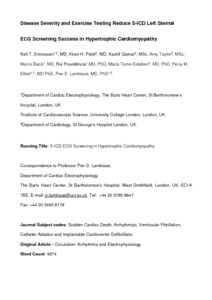Srinivasan, NT; Patel, KH; Qamar, K; Taylor, A; Bacà, M; Providência, R; Tome-Esteban, M; Elliott, PM; Lambiase, PD
(2017)
Disease Severity and Exercise Testing Reduce Subcutaneous Implantable Cardioverter-Defibrillator Left Sternal ECG Screening Success in Hypertrophic Cardiomyopathy.
Circ Arrhythm Electrophysiol, 10 (4).
e004801.
ISSN 1941-3084
https://doi.org/10.1161/CIRCEP.117.004801
SGUL Authors: Tome, Maria Teresa
![[img]](https://openaccess.sgul.ac.uk/113725/1.hassmallThumbnailVersion/Lambiase_Circ%20Ep%20manuscript%20edited%20rebuttal%20manuscript%20with%20line%20numbers%20no%20markings.pdf)  Preview |
|
PDF
Accepted Version
Available under License ["licenses_description_publisher" not defined].
Download (366kB)
| Preview
|
Abstract
BACKGROUND: The features of the hypertrophic cardiomyopathy (HCM) ECG make it a challenge for subcutaneous implantable cardioverter-defibrillator (S-ICD) screening. We aimed to investigate the causes of screening failure at rest and on exercise to inform optimal S-ICD ECG vector development. METHODS AND RESULTS: One hundred and thirty-one HCM patients (age, 50±16 years; 92 males and 39 females) with ≥1 HCM risk factor for sudden death underwent S-ICD ECG screening at rest and on exercise. Fifty patients (38%) were ineligible for S-ICD because of screening failure in every lead vector: 33 (66%) failed in the supine position, 12 (24%) failed in the standing position, and 5 (10%) failed on exercise. In patients who could exercise and passed screening at rest, 31 (44%) had 1 vector safety, 16 (23%) had 2 vector safety, and 24 (33%) had 3 vector safety. Increased R:T wave ratio in the S-ICD screening ECG (odds ratio, 4.0; confidence interval, 3.0-5.3; P<0.001) was associated with screening failure, while R/T ratio <3 in aVF (odds ratio, 0.3; confidence interval, 0.12-0.69; P=0.006) and increasing age (odds ratio, 0.97; confidence interval, 0.95-0.99; P=0.03) was associated with reduced screening failure. European Society of Cardiology risk score was higher in those failing screening (risk score 5.5% [interquartile range, 3.2-8.7] in failed versus 4.5% [interquartile range, 2.9-7.4] in passed; P=0.04). CONCLUSIONS: HCM patients have a significant incidence of screening failure, which is determined primarily by the increased R:T ratio on the screening ECG and lead aVF. High-risk patients have an increased screening failure rate. Optimization of sensing algorithms is required to ensure that the highest risk HCM patients can benefit from S-ICD implantation.
| Item Type: |
Article
|
| Additional Information: |
This is a non-final version of an article published in final form in Srinivasan, NT; Patel, KH; Qamar, K; Taylor, A; Bacà, M; Providência, R; Tome-Esteban, M; Elliott, PM; Lambiase, PD (2017) Disease Severity and Exercise Testing Reduce Subcutaneous Implantable Cardioverter-Defibrillator Left Sternal ECG Screening Success in Hypertrophic Cardiomyopathy. Circ Arrhythm Electrophysiol, 10 (4). |
| Keywords: |
S-ICD, S-ICD screening, arrhythmia, hypertrophic cardiomyopathy, sudden cardiac death, Action Potentials, Adult, Aged, Algorithms, Cardiomyopathy, Hypertrophic, Chi-Square Distribution, Death, Sudden, Cardiac, Decision Support Techniques, Defibrillators, Implantable, Electric Countershock, Electrocardiography, Exercise Test, Female, Heart Rate, Humans, Logistic Models, Male, Middle Aged, Multivariate Analysis, Odds Ratio, Patient Positioning, Patient Selection, Predictive Value of Tests, Reproducibility of Results, Risk Factors, Severity of Illness Index, Supine Position, Humans, Cardiomyopathy, Hypertrophic, Death, Sudden, Cardiac, Electrocardiography, Exercise Test, Electric Countershock, Severity of Illness Index, Multivariate Analysis, Logistic Models, Odds Ratio, Risk Factors, Chi-Square Distribution, Reproducibility of Results, Predictive Value of Tests, Defibrillators, Implantable, Action Potentials, Heart Rate, Supine Position, Algorithms, Decision Support Techniques, Patient Selection, Adult, Aged, Middle Aged, Female, Male, Patient Positioning, arrhythmia, hypertrophic cardiomyopathy, S-ICD, S-ICD screening, sudden cardiac death, S-ICD, S-ICD screening, arrhythmia, hypertrophic cardiomyopathy, sudden cardiac death, Action Potentials, Adult, Aged, Algorithms, Cardiomyopathy, Hypertrophic, Chi-Square Distribution, Death, Sudden, Cardiac, Decision Support Techniques, Defibrillators, Implantable, Electric Countershock, Electrocardiography, Exercise Test, Female, Heart Rate, Humans, Logistic Models, Male, Middle Aged, Multivariate Analysis, Odds Ratio, Patient Positioning, Patient Selection, Predictive Value of Tests, Reproducibility of Results, Risk Factors, Severity of Illness Index, Supine Position, Cardiovascular System & Hematology |
| SGUL Research Institute / Research Centre: |
Academic Structure > Molecular and Clinical Sciences Research Institute (MCS) |
| Journal or Publication Title: |
Circ Arrhythm Electrophysiol |
| ISSN: |
1941-3084 |
| Language: |
eng |
| Publisher License: |
Publisher's own licence |
| Projects: |
|
| PubMed ID: |
28408651 |
| Web of Science ID: |
WOS:000399571700007 |
| Dates: |
| Date |
Event |
| 2017-04 |
Published |
| 2017-04-13 |
Published Online |
| 2017-03-07 |
Accepted |
|
 |
Go to PubMed abstract |
| URI: |
https://openaccess.sgul.ac.uk/id/eprint/113725 |
| Publisher's version: |
https://doi.org/10.1161/CIRCEP.117.004801 |
Statistics
Item downloaded times since 04 Oct 2021.
Actions (login required)
 |
Edit Item |



